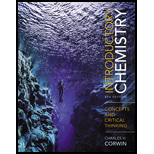
(a)
Interpretation:
The electronic configuration of
Concept introduction:
A representation of filling of electrons in orbitals in a systematic manner is known as electronic configuration. The pattern of filling of electrons is based on three principles that are Aufbau principle, Pauli-exclusion principle, and Hund’s rule.
(b)
Interpretation:
The electronic configuration of
Concept introduction:
A representation of filling of electrons in orbitals in a systematic manner is known as electronic configuration. The pattern of filling of electrons is based on three principles that are Aufbau principle, Pauli-exclusion principle, and Hund’s rule.
(c)
Interpretation:
The electronic configuration of
Concept introduction:
A representation of filling of electrons in orbitals in a systematic manner is known as electronic configuration. The pattern of filling of electrons is based on three principles that are Aufbau principle, Pauli-exclusion principle, and Hund’s rule.
(d)
Interpretation:
The electronic configuration of
Concept introduction:
A representation of filling of electrons in orbitals in a systematic manner is known as electronic configuration. The pattern of filling of electrons is based on three principles that are Aufbau principle, Pauli-exclusion principle, and Hund’s rule.
Want to see the full answer?
Check out a sample textbook solution
Chapter 12 Solutions
Introductory Chemistry: Concepts and Critical Thinking Plus MasteringChemistry with eText -- Access Card Package
- For many years after they were discovered, it was believed that the noble gases could not form compounds. Now we know that belief to be incorrect. A mixture of xenon and fluorine gases, confined in a quartz bulb and placed on a windowsill, is found to slowly produce a white solid. Analysis of the compound indicates that it contains 77.55% Xe and 22.45% F by mass.(a) What is the formula of the compound?(b) Write a Lewis structure for the compound.(c) Predict the shape of the molecules of the compound.(d) What hybridization is consistent with the shape you predicted?arrow_forwardWrite the chemical formulas for the following compounds:(a) Silver cyanide(b) Calcium hypochlorite(c) Potassium chromate(d) Gallium oxide(e) Potassium superoxide(f) Barium hydrogen carbonatearrow_forwardWhich of the following ions possess a noble gas electron configuration? Please select all that apply (a) K+ (b) H- (c) F- (d) He+ (e) O (f) Ca2+?arrow_forward
- Give the group number and the general valence electron configuration of an element with the following electron-dot symbol. (For example, type ns2 np6 for ns²np°, which is the valence configuration of all group 8A elements.) (a) group number electron configuration (b) group number electron configurationarrow_forwardGive a reason why each of the following statements is a safeprediction:(a) Every compound of Rb with a nonmetal is ionic in character.(b) Every compound of nitrogen with a halogen element is amolecular compound.(c) The compound MgKr2 does not exist.(d) Na and K are very similar in the compounds they form withnonmetals.(e) If contained in an ionic compound, calcium (Ca) will be inthe form of the doubly charged ion, Ca2arrow_forwardChoosing from the elements in the third row of the Periodic Table write out thechemical formula of(i) A basic oxide.(ii) An amphoteric oxide.(iii) An acidic oxidearrow_forward
- (c) Theoretically, define the following elements in the formulae belowPth = ρghq x ŋarrow_forward1. Use condensed electron configurations and Lewis electron-dot symbols to depict the ions formed from each of the following atoms, and predict the formula of their compound: (a) Cs and S (b) O and Ga (c) N and Mg (d) Br and Liarrow_forwardUse condensed electron configurations and Lewis electron-dot symbols to depict the ions formed from each of the follow-ing atoms, and predict the formula of their compound:(a) Cs and S (b) O and Ga (c) N and Mg (d) Br and Liarrow_forward
- Write out the full electron configuration for each of the following atoms and for the monatomic ion found in binary ionic compounds containing the element:(a) Al(b) Br(c) Sr(d) Li(e) As(f) Sarrow_forwardDetermine what is wrong with each ionic Lewis structure and write the correct structure.arrow_forwardArrange in order of increasing nonmetallic character. (a) the period 4 elements Ga, Ge, Ti (b) the Group 5A elements P, Bi, and Narrow_forward
 Introduction to General, Organic and BiochemistryChemistryISBN:9781285869759Author:Frederick A. Bettelheim, William H. Brown, Mary K. Campbell, Shawn O. Farrell, Omar TorresPublisher:Cengage LearningChemistry: Matter and ChangeChemistryISBN:9780078746376Author:Dinah Zike, Laurel Dingrando, Nicholas Hainen, Cheryl WistromPublisher:Glencoe/McGraw-Hill School Pub Co
Introduction to General, Organic and BiochemistryChemistryISBN:9781285869759Author:Frederick A. Bettelheim, William H. Brown, Mary K. Campbell, Shawn O. Farrell, Omar TorresPublisher:Cengage LearningChemistry: Matter and ChangeChemistryISBN:9780078746376Author:Dinah Zike, Laurel Dingrando, Nicholas Hainen, Cheryl WistromPublisher:Glencoe/McGraw-Hill School Pub Co Chemistry for Engineering StudentsChemistryISBN:9781337398909Author:Lawrence S. Brown, Tom HolmePublisher:Cengage Learning
Chemistry for Engineering StudentsChemistryISBN:9781337398909Author:Lawrence S. Brown, Tom HolmePublisher:Cengage Learning Introductory Chemistry: A FoundationChemistryISBN:9781337399425Author:Steven S. Zumdahl, Donald J. DeCostePublisher:Cengage Learning
Introductory Chemistry: A FoundationChemistryISBN:9781337399425Author:Steven S. Zumdahl, Donald J. DeCostePublisher:Cengage Learning



